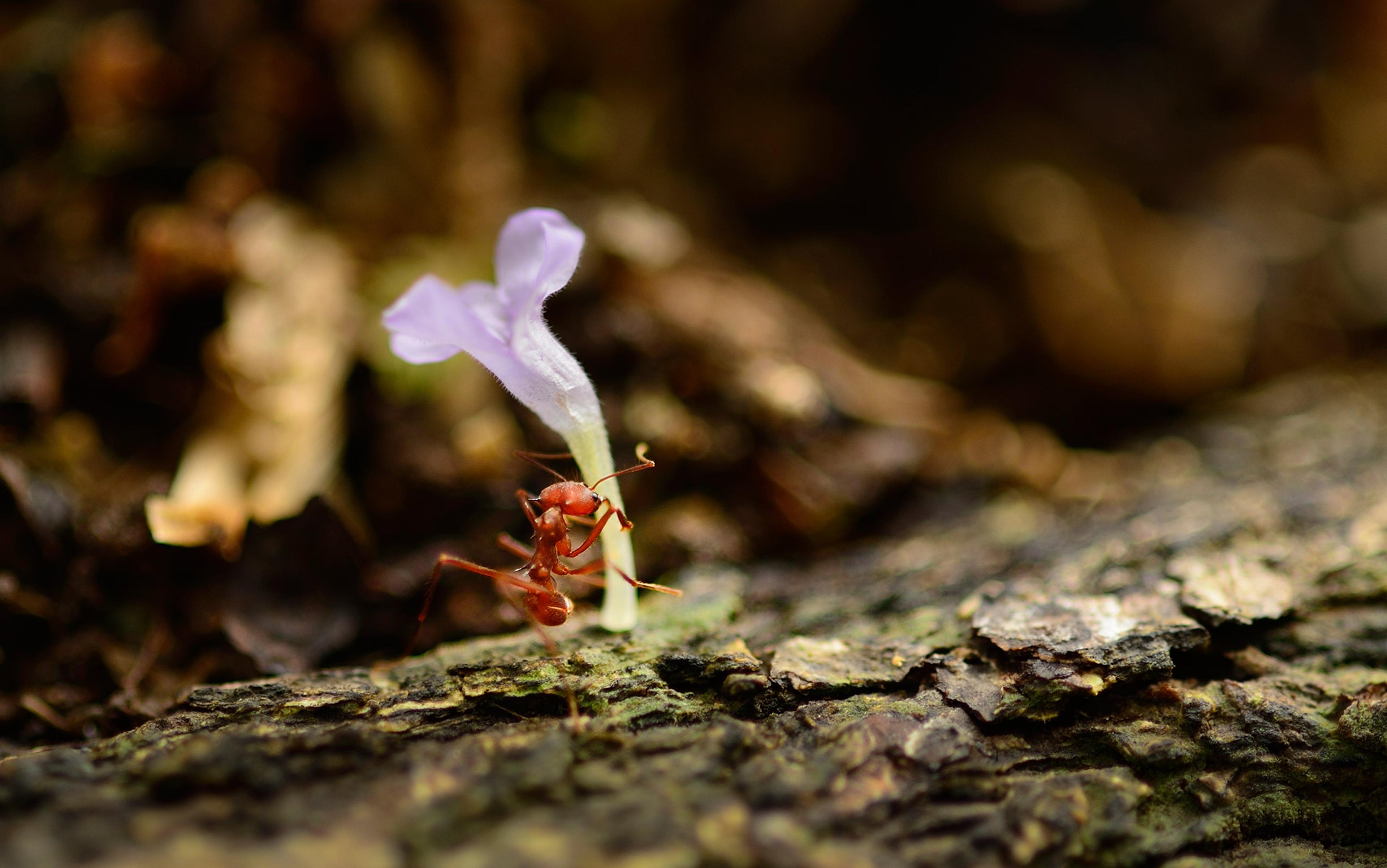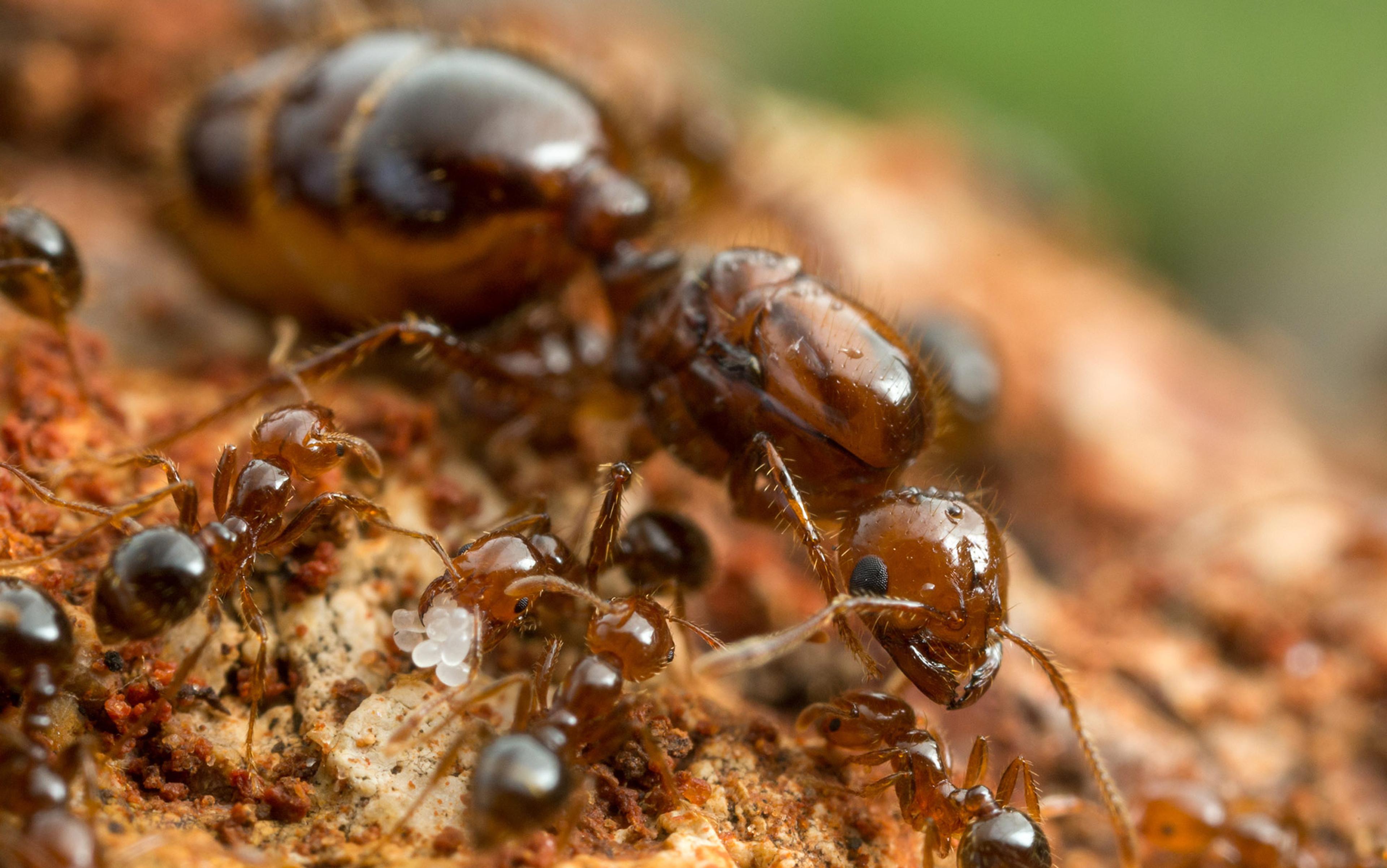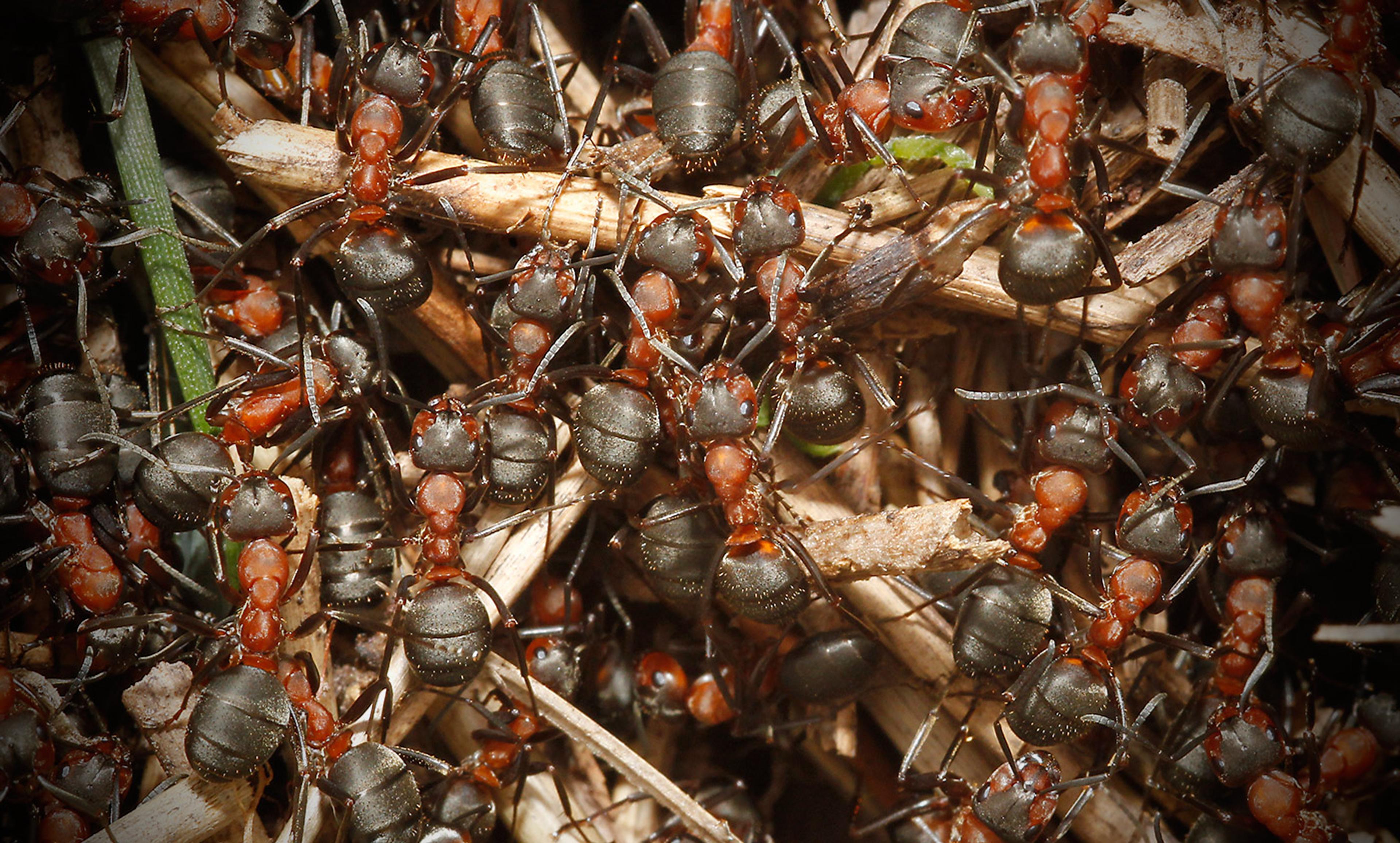It’s easy to find familiar examples of division of labour. In a corporation, some people work in sales and others in accounting; in an orchestra, some play the bassoon and others the violin. Since no one is born an accountant or a bassoonist, in a system with division of labour, differentiated skills must be acquired. ‘Division of labour’ evokes an organisation characterised by a fit between role – what each participant does – and its natural ability.
Historically, many have found the idea of division of labour a compelling and powerful model. Plato admired it, Adam Smith explained how economies benefit from it, and Henry Ford industrialised it. But it’s not natural. A vision of human society ordered and improved by division of labour has permeated and distorted our understanding of nature. In high-school biology, for example, people are taught that a body consists of cells specialised to perform certain functions. Skin cells stick together and seal wounds, while blood cells hurtle along picking up and handing off oxygen. But different kinds of cells originate from a few identical ones, and some cells, such as stem cells, can change type. Textbooks tell us that these are merely transitory stages along the way to the ideal condition in which each cell does its particular job.
Ant colonies seem the perfect natural instance of a social system governed by division of labour. All known species of ants – now about 14,000 – live in colonies. An ant colony consists of one or more reproductive females, called ‘queens’, who lay the eggs. All the rest of the ants, the ones you see walking around, are sterile female ‘workers’, daughters of the queen and the males with whom she mated.
In the 1970s, the biologist E O Wilson set the agenda for research on ants by extolling the virtues of division of labour. He freely used metaphors from human society to describe a colony as a ‘factory within a fortress’. In this metaphor, each ant is programmed to carry out its appointed task. Some ants feed the larvae; while others go out to get food. Using a term that refers to ascribed social positions in Hindu society, Wilson called an ant’s task its ‘caste’. The idea was that an ant’s task is fixed. The implication was that the workers in an ant colony, all sisters or half-sisters, are divided into naturally fixed groups, and genetically programmed to perform a particular task. This perspective is depicted in the movie Antz (1998): a harried bureaucrat stamps each larva as a soldier or forager. Thus each ant’s role is unalterable destiny, much like the handsome and intelligent Alphas and the semi-moronic Epsilons of Aldous Huxley’s Brave New World (1931).
We know now that ants do not perform as specialised factory workers. Instead ants switch tasks. An ant’s role changes as it grows older and as changing conditions shift the colony’s needs. An ant that feeds the larvae one week might go out to get food the next. Yet in an ant colony, no one is in charge or tells another what to do. So what determines which ant does which task, and when ants switch roles?
The colony is not a monarchy. The queen merely lays the eggs. Like many natural systems without central control, ant societies are in fact organised not by division of labour but by a distributed process, in which an ant’s social role is a response to interactions with other ants. In brief encounters, ants use their antennae to smell one another, or to detect a chemical that another ant has recently deposited. Taken in the aggregate, these simple interactions between ants allow colonies to adjust the numbers performing each task and to respond to the changing world. This social coordination occurs without any individual ant making any assessment of what needs to be done.
For millennia, ants have been held up as models for human societies, characterised by coordinated and efficient mutual regard and selfless hard work. In The Iliad, Zeus changes the ants of Thessaly to soldiers after a plague wiped out the men, creating the Myrmidons, who beat back the Trojans. Aesop’s fable of the ant and the grasshopper celebrates the ant’s capacity for delayed gratification, collecting food to be used later. Unlike the frivolous and short-sighted grasshopper, the virtuous ants contribute to their society. Aesop’s ant lugging a seed home is bringing food for the colony. Similarly, the Myrmidon’s willingness to sacrifice, in their case their lives, makes them heroic soldiers in Achilles’ army.
In 1747, when the English naturalist William Gould listed the ‘moral Instructions arising from the Sight of a Colony of Ants’, he pointed out that the ants worked ‘for the common Emolument, [that] might let us know the Consequence of Public Good’. Each ant, he observed, is dedicated to the task it ought to do for the benefit of the others. The modern scientific narrative about the division of labour that characterises ant colonies tells essentially the same story: ants demonstrate that if everyone does the job they are supposed to do, indeed were born to do, all of us are better off.
In a system organised by division of labour, each individual specialises in a particular task. The specialisation is justified because of differences among individuals in how well they perform tasks. Division of labour always entails specialisation, but it can take different forms. Plato favoured the horizontal form, in which a single actor performs each task. Adam Smith preferred the vertical, in which different people accomplish parts of a single task. Henry Ford extended and expanded the vertical form in the flow of work in a factory.
‘Why is it, every time I ask for a pair of hands, they come with a brain attached?’
Division of labour offers advantages to human society because, among other reasons, people differ in abilities. Plato considered these differences in ability a matter of talent as well as preference:
One man is good at one thing, another at another … So more things are produced, and better things, when every man does what he can do best, without being troubled by having to do other things in addition.
For Smith, division of labour brought the advantage of learning and improvement, ‘the increase in dexterity’ that comes of repeating a task. It also brought increases in efficiency; Smith saw changing tasks as an opportunity for a workman to slack off, engaging in ‘sauntering and… indolent careless application, [which] almost always renders him slothful and lazy’.
Ford shared more of Smith’s views about division of labour than Plato’s. He didn’t care about talent or learning. ‘Why is it,’ Ford complained, ‘every time I ask for a pair of hands, they come with a brain attached?’ Ford was interested in speed. He realised that, troubled or not, people could work faster if they didn’t have to put down one tool and pick up another.
When Wilson introduced the notion of ant colonies organised by the division of labour, he framed it as evidence that natural selection had shaped workers to do the tasks they do best. An ant emerges from a pupa as an adult of a certain size, and stays that size throughout its life. In some species, there are ants of different sizes within a colony. Wilson claimed that task and body type coincide: large ants would be soldiers, smaller ones dedicated to more domestic tasks.
In fact, the data here are sparse and contradictory. Though the largest ants are often designated as ‘soldiers’, in fights between ant species the smaller species often prevails. A large ant, for example, is helpless if six tiny ones grab each of its legs. In some species in the genus Pheidole, the large-headed ‘soldiers’ show no military inclinations; instead they tend to stay in the nest and use their large jaw muscles to crack seeds. But if there are not enough small ants to go outside and forage, the larger ones will do the same tasks as the smaller ones.
In advocating the division of labour model, Wilson argued that ant workers of a certain size performed certain tasks better than workers of another size. In this view, the leaf-cutter ants cutting the leaves were not too big, not too small, but just right for leaf-cutting. It’s an appealing theory, but there is no real evidence that ants of a certain size do one task better than others. Another challenge to the generality of the theory is that in the great majority (about 276 of 326) of genera of ants, all the ants in a colony are the same size. Moreover, regardless of size, as ant workers get older, they move from one task to another, switching tasks as circumstances require. But switching tasks, either in stages of life or in the short term, is not consistent with organisation by division of labour. However appealing it might be to imagine ant colonies organised by division of labour, the evidence tells us they are not.
What I and others have found, instead, is that the collective process of task allocation in ant colonies is based on networks of simple interactions. For example, in harvester ants, colonies regulate foraging activity, adjusting the numbers of ants currently out searching for seeds to the amount of food available. An outgoing forager does not leave the nest until it meets enough returning foragers coming back with food. This creates a simple form of positive feedback: the more food is available, the more quickly foragers find it, and the more quickly they return to the nest, eliciting more foraging. When I provide a windfall of food by placing a lovely little pile of organic millet outside the colony, ants that formerly performed other tasks switch to become foragers. Each encounter, in the form of a brief antennal contact, has no meaning to the ant, but in the aggregate, the rate of encounters determines how many ants are currently foraging.
The system that ant colonies use to organise their work is a distributed process. Like division of labour, distributed processes can take different forms. A distributed process is not the opposite of division of labour – but it’s different in important ways. Primarily, in a distributed process, there is never central control, while in division of labour there might be. A leader can tell one citizen to make candles and another to make shoes. In a distributed process this would happen through local interactions, for example with people who want to buy candles or shoes – creating demand that is filled by an entrepreneur who then meets the demand.
Most fathers might not be as good at changing diapers as most mothers but, at 3am, the finer points of technique don’t matter
At least in the short term, a system organised by a distributed process and one organised by division of labour could look the same: the same individuals could do the same task over and over. An ant might do the same task day after day. It might go out to forage, come back to the nest, engage again in the interactions that stimulate it to forage, and spend the night among other ants that recently returned from foraging. The next morning, it is again in a situation in which it is likely to forage, and this could continue day after day. However, in different conditions, the ant might do another task, and so its role is not fixed.
Distributed processes and division of labour can both be effective, but they don’t function in the same way. For division of labour, specialisation can lead to better work. By contrast, in a distributed process, the fact that individuals are interchangeable makes the whole system more robust and more resilient. If the individual who performs a task gets lost or becomes unfit to do it, another can step in. The individuals don’t have to be all alike, but the differences among them are not large enough to affect the viability of the system. Most fathers might not be as good at changing diapers as most mothers but, at 3am, the finer points of technique don’t matter. If anyone changes the diaper, the baby goes back to sleep.
The term ‘distributed process’ originated in computer science. There, it means that no single unit, such as a router in a data network, knows what all the others are doing and tells them what to do. Instead, interactions between each unit and its local connections add up to the desired outcome. Distributed processes often operate in parallel rather than in series. An assembly line works in series: the handle of the car door must be put on before the door is installed, and the door can’t be installed until the person who puts on the handle has finished. In a parallel process, different steps can be done at the same time. Suppose each worker built a car from beginning to end. Then if one worker takes a little longer to put on the door handle on one car, this will not affect when the next worker can install the door on their car. If all the tasks are relatively simple, parallel processes go much faster than serial ones. This is true of computers, in which the logic gates perform very simple tasks, creating electrical versions of 1s and 0s. Compared with processing in series, parallel processing makes it possible to accomplish far more elaborate operations in a short time.
Because data networks, such as the internet, are undergoing very rapid growth, distributed processes are attracting great interest. But they entail a fundamental departure from systems based on central control: for many distributed algorithms, the outcome is not completely predictable. Although it’s possible to say what will happen on average, what will happen in particular cases can’t be specified precisely. Such uncertainty is inimical to the hearts of engineers who love things to work the same way every time. That engineers value predictability is a good thing for all of us who cross bridges and travel in airplanes. But distributed processes have distinct advantages for certain kinds of engineered systems, such as large data or electrical networks, in which the failure of one tiny part is not critical. They create redundancy at the expense of efficiency, and sacrifice precision for solutions that are good enough most of the time.
Distributed processes also have analogues in nature. In the 1970s and ’80s, as computer scientists saw the value of distributed processes in programming, they began to point out the analogies with natural systems. Douglas Hofstadter’s influential book Gödel, Escher, Bach (1979) used ant colonies and brains as metaphors for computer systems. David Rumelhart, another computer scientist, extended this idea to neural networks, models that explain how parts of a brain might work using parallel distributed processes. Now, scientists are studying distributed algorithms throughout nature, from circuits formed by neurons in brains or the interactions of metastasising cancer cells, to the movement of a flock of starlings or school of fish.
Ants can show how distributed processes might allow us to adjust to a changing environment; to build nests, decide when to move, or change from working inside the nest to foraging outside. It is becoming clear that the ant colonies’ algorithms are diverse, in interesting ways. Similar processes are at work in other natural systems without central control. For example, although certain large regions of the brain seem to be involved in particular tasks, at the level of neurons it looks like division of labour is not the rule. The same neurons are involved in different tasks, and the same task can be accomplished by different neurons.
We say that disease, psychosis and athletic ability are ‘genetic’, as if we had little switches labelled ‘cancer’ or ‘paranoia’ or ‘endurance’ inside
It can be very difficult to let go of the idea of division of labour. Humans have always used arguments about supposedly intrinsic attributes to justify social roles. Kings ruled by divine right and ancestry, while others were slaves based on race or physical attributes. Such ideas pervade the rhetoric of US society and politics. We are told that Mexicans are rapists and Muslims are terrorists and, from the other side, a much more benign version but deriving from a similar philosophical stance: that Americans are optimistic and energetic.
Such explanations, relying on intrinsic attributes rather than relations and circumstances, also dominate our views of nature. Last summer, for instance, a bride whose father had died asked the man who received her father’s transplanted heart to give her away at her wedding. It is the heart’s job to love, therefore her father’s feelings must reside in her father’s heart. Genetic determinism is another example. We say that disease, intelligence, psychosis, athletic ability and so on are ‘genetic’, as if inside a person’s cells there were little switches labelled ‘cancer’ or ‘paranoia’ or ‘endurance’. In fact stress, sunlight, exercise and similar influences can change which genes are turned off and on. Biologists are learning that what genes do depends as much on what is happening outside as well as inside the cell.
So why is the ant colony as a factory of specialised workers such a compelling image? First, it’s familiar: a little city of ants, each carrying out its assigned job, is a miniature version of a human city. It’s comforting to imagine that each ant gets up in the morning, drinks its coffee, grabs its briefcase and goes off to work. To envisage how an ant’s task of the moment arises from a pulsing network of brief, meaningless interactions might compel us instead to ponder what really accounts for why each of us has a particular job.
Secondly, in general, explanations are often easier to accept if they invoke internal properties that are invisible and thus, like the Wizard of Oz behind his curtain, do not require any further inspection. In the language of experimental science, the factors that matter but that we can’t see are said to be inside ‘a black box’. We just ignore them while investigating the others that we can see. But to say that someone does something because that is ‘who they are’, ‘how they are wired’, or that it is ‘genetic’ or a result of stuff in their brain, is no explanation at all. It just makes it possible for us to move on by begging the question. Buddha insisted that the ‘doctrine of self’, based on the notion that a person is a collection of fixed properties, is a fallacy. The alternative, that a person is a shifting flux of impressions and feelings, lacking a defined core, is difficult to grasp.
The most fundamental appeal to the idea of division of labour is, perhaps, that it provides a reassuring sense of control. If each individual’s task is not determined by his particular aptitude, then what determines who does what? It is comforting to think that at least some invisible force – and natural selection is a powerful example – has imparted an order that makes everything as it should be. For some religious people, God does this. While divine right makes one man a king, it also gives all the subjects a narrative in which all is just as it ought to be.
Reality is less soothing but much more interesting. A distributed process can be messy and not fully predictable, yet can provide greater resilience and robustness. Such distributed processes might not be ideal as one of the ‘major instruments of social stability’, in the words of the Director of Hatcheries in Brave New World, but they work beautifully in nature, from brains to ant colonies and, increasingly, in our own engineered networks.
Division of labour is a human innovation, drawing on our ability to learn and improve by practice, and to trade goods and services. The growing recognition that natural processes work differently from our symphonies and armies will allow us to see the natural world more clearly. Ant colonies are not factories or fortresses; instead they use simple interactions to adjust to changing conditions. Ant societies, organised by distributed algorithms rather than division of labour, have thrived for more than 130 million years.






